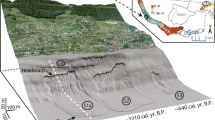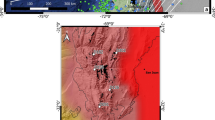Abstract
This study of subaquatic slope failures in Lake Lucerne, central Switzerland, presents a new concept for evaluating basin-wide slope stability through time as a potential tool for regional seismic and tsunami hazard assessments. Previously acquired high-resolution bathymetry and reflection seismic data, as well as sedimentological and in situ geotechnical data, provide a comprehensive data base to use this lake as a “model basin” to investigate subaquatic landslides and related geohazards. Available data are implemented into a basin-wide slope model. In a Geographic Information System (GIS)-framework, a pseudo-static limit equilibrium infinite slope stability equation is solved for each model point representing reconstructed slope conditions at different times in the past, during which earthquake-triggered landslides occurred. Comparison of reconstructed critical stability conditions with the known distribution of landslide deposits reveals minimum and maximum threshold conditions for slopes that failed or remained stable, respectively. The resulting correlations reveal good agreements and suggest that the slope stability model generally succeeds in reproducing past events. The basin-wide mapping of subaquatic slope failure susceptibility through time thus can also be considered as a promising paleoseismologic tool. Furthermore, it can be used to assess the present-day slope failure susceptibility, allowing for identification of location and estimation of size of future, potentially tsunamigenic subaquatic landslides.









Similar content being viewed by others
References
Bardet JP, Synolakis CE, Davies HL, Imamura F, Okal EA (2003) Landslide tsunamis: recent findings and research directions. Pure Appl Geophys 160:1793–1809. doi:10.1007/s00024-003-2406-0
Bay F, Wiemer S, Fäh D, Giardini D (2005) Predictive ground motion scaling in Switzerland: best estimates and uncertainties. J Seismol 9:223–240. doi:10.1007/s10950-005-5129-0
Biscontin G, Pestana JM, Nadim F (2004) Seismic triggering of submarine slides in soft cohesive soil deposits. Mar Geol 203:341–354. doi:10.1016/S0025-3227(03)00314-1
Boe R, Longwa O, Lepland A et al (2004) Postglacial mass movements and their causes in fjords and lakes in western Norway. Norw J Geol 84:35–55
Bührer H, Ambühl H (1996) Der Vierwaldstättersee 1961–1992—Eine Dokumentation. Schriftenreihe der EAWAG, 10, 54 pp.
Camerlenghi A, Urgeles R, Ercilla G, Brückmann W (2007) Scientific Ocean drilling behind the assessment of geo-hazards from submarine slides. Sci Drill 4:45–47. doi:10.2204/iodp.sd.4.14.2007
Cysat R (1601) Collectanea Chronica und denkwürdige Sachen pro Chronica Lucernensi et Helvetiae. In: Schid J (ed) Quellen und Forschungen zur Kulturgeschichte von Luzern und der Innerschweiz. Diebold Schilling Verlag, Luzern, pp 882–888
De Batist M, Chapron E (2008) Lake systems: sedimentary archives of climate change and tectonics. Palaeogeogr Palaeoclimatol Palaeoecol 259:93–95. doi:10.1016/j.palaeo.2007.10.016
Dugan B, Flemings PB (2000) Overpressure and fluid flow in the New Jersey continental slope: implications for slope failure and cold seeps. Science 289:288–291. doi:10.1126/science.289.5477.288
Girardclos S, Schmidt OT, Sturm M, Ariztegui D, Pugin A, Anselmetti FS (2007) The 1996 AD delta collapse and large turbidite in Lake Brienz. Mar Geol 241:137–154. doi:10.1016/j.margeo.2007.03.011
Gisler M, Fäh D, Kästli P (2004) Historical seismicity in Central Switzerland. Eclogae Geol Helv 97:221–236. doi:10.1007/s00015-004-1128-3
Goldfinger C, Nelson CH, Johnson JE (2003) Holocene earthquake records from the Cascadia subduction zone and northern San Andreas Fault on precise dating of offshore turbidites. Annu Rev Earth Planet Sci 3:555–577. doi:10.1146/annurev.earth.31.100901.141246
Gorsevski PV, Gessler PE, Boll J, Elliot WJ, Foltz RB (2006) Spatially and temporally distributed modeling of landslide susceptibility. Geomorphology 80:178–198. doi:10.1016/j.geomorph.2006.02.011
Hampton MA, Lee HJ, Locat J (1996) Submarine landslides. Rev Geophys 34:33–59
Hilbe M, Anselmetti FS, Eilertsen RS, Hansen L (2008) Spuren von Massenbewegungen auf dem Grund des Vierwaldstättersees bei Weggis: Die Ereignisse von 1601 und 1795. Bull Angewandte Geol 13:83–85
Inouchi Y, Kinugasa Y, Kumon F, Nakano S, Ysumatsu S, Shiki T (1996) Turbidites as record of intense paleoearthquakes in Lake Biwa, Japan. Sediment Geol 104:117–125. doi:10.1016/0037-0738(95)00124-7
Kelts K, Hsü KJ (1980) Resedimented facies of 1875 Horgen slumps in Lake Zurich as a process model of longitudinal transport of turbidity currents. Ecologae Geol Helv 73:271–281
Kreiter S, Moerz T, Strasser M, Lange M, Schunn W, Schlue BF, Otto D, Kopf A (2010) Advanced dynamic soil testing—introducing the new MARUM dynamic triaxial testing device. In: Mosher DC et al (eds) Submarine mass movements and their consequences. Advances in Natural and Technological Hazards Series. Springer, Berlin, pp 31–41
Lee HJ, Edwards BD (1986) Regional method to assess offshore slope stability. J Geotech Geoenviron Eng 112:486–509
Lee HJ, Locat J, Dartnell P, Israel K, Wong F (1999) Regional variability of slope stability: application to the Eel margin, California. Mar Geol 154:305–332. doi:10.1016/S0025-3227(98)00120-0
Lee HJ, Locat J, Dartnell P, Minasian D, Wong F (2000) A GIS-based regional analysis of the potential for shallow-seated submarine slope failure. In: Proceedings of 8th international symposium on landslides, Cardiff, Wales, June 26–30, pp 917–922
Lee HJ, Locat J, Desgagnes P, Parson JD, McAdoo BG, Orange DL, Puig P, Wong FL, Dartnell P, Boulanger E (2007) Submarine mass movements on continental margins. In: Nittrouer CA, Austin JA, Field ME, Kravitz JH, Syvitski JPM, Wiber P (eds) Continental margin sedimentation, IAS Special Publication, vol 37, pp 213–274
Lemcke G (1992) Ablagerungen aus Extremereignissen als Zeitmarker der Sedimentationsgeschichte im Becken von Vitznau/Weggis (Vierwaldstättersee, Schweiz). MS thesis Thesis, Georg-August-Universtität Götting, Götting, 154 pp.
Locat J, Lee HJ (2002) Submarine landslides: advances and challenges. Can Geotech J 39:193–212
Locat P, Leroueil S, Locat J, Duchesne MJ (2003) Characterisation of submarine flow-slide at Pointe-Du-Fort, Saguenay Fjord, Quebec, Canada. In: Locat J, Mienert J (eds) Submarine mass movements and their consequences, pp 521–529
Mankelow JM, Murphy W (1998) Using GIS in the probabilistic assessment of earthquake triggered landslide hazards. J Earthq Eng 2:593–623
Masson DG, Harbitz CB, Wynn RB, Pedersen G, Lovholt F (2006) Submarine landslides: processes triggers and hazard prediction. Philos Trans R Soc A Math Phys Eng Sci 364:2009–2039. doi:10.1098/rsta.2006.1810
Miles SB, Keefer DK (2000) Evaluation of seismic slope-performance models using a regional case study. Environ Eng Geosci 6:25–39
Moernaut J, De Batist M, Charlet F, Heirman K, Chapron E, Pino M, Brummer R, Urrutia R (2007) Giant earthquake in South-Central Chile revealed by Holocene mass-wasting events in Lake Puyehue. Sed Geol 195:239–256. doi:10.1016/j.sedgeo.2006.08.005
Monecke K, Anselmetti FS, Becker A, Sturm M, Giardini D (2004) The record of historic earthquakes in lake sediments of Central Switzerland. Tectonophysics 394:21–40. doi:10.1016/j.tecto.2004.07.053
Morgan JK, Silver E, Camerlenghi A, Dugan B, Kirby S, Shipp C, Suyehiro K (2009) Addressing geohazards through ocean drilling. Sci Drill 7:15–30. doi:10.2204/iodp.sd.7.01.2009
Morgenstern NR (1967) Submarine slumping and initiation of turbidity currents. In: Richards AF (ed) Mar. Geotechnique UP, Urbana, IL, pp 189–220
Murphy JR, O’Brien LJ (1977) The correlation of peak ground acceleration amplitude with seismic intensity and other physical parameters. Bull Seismol Soc Am 67:877–915
Owen M, Day S, Maslin M (2007) Late Pleistocene submarine mass movements: occurrence and causes. Quat Sci Rev 26:958–978. doi:10.1016/j.quascirev.2006.12.011
Schnellmann M, Anselmetti FS, Giardini D, McKenzie JA, Ward SN (2002) Prehistoric earthquake history revealed by lacustrine slump deposits. Geology 30:1131–1134. doi:10.1130/0091-7613(2002)030<1131:PEHRBL>2.0.CO;2
Schnellmann M, Anselmetti FS, McKenzie JA, Giardini D (2005) Mass movement-induced fold-and-thrust belt structures in unconsolidated sediments in Lake Lucerne (Switzerland). Sedimentology 52:271–289. doi:10.1111/j.1365-3091.2004.00694.x
Schnellmann M, Anselmetti FS, McKenzie JA, Giardini D (2006) 15, 000 Years of mass-movement history in Lake Lucerne: implications for seismic and tsunami hazards. Eclogae Geol Helv 99:409–428. doi:10.1007/s00015-006-1196-7
Schwarz-Zanetti G, Deichmann N, Fäh D, Giardini D, Jimenez MJ, Masciadri V, Schibler R, Schnellman M (2003) The earthquake in Unterwalden on September 18, 1601: a historic-critical macroseismic evaluation. Eclogae Geol Helv 96:441–450
Seed HB (1979) Considerations in earthquake-resistant design of earth and rock-fill dams. Géotechniques 29:215–263
Seed HB, Idriss IM (1971) Simplified procedure for evaluating soil liquefaction potential. J Soil Mech Found Div Proc Am Soc Civil Eng 97:1249–1273
Siegenthaler C, Finger W, Kelts K, Wang S (1987) Earthquake and Seiche Deposits in Lake Lucerne, Switzerland. Eclogae Geol Helv 80:241–260
Stegmann S, Strasser M, Anselmetti FS, Kopf A (2007) Geotechnical in situ characterisation of subaquatic slopes: the role of pore pressure transients versus frictional strength in landslide initiation. Geophys Res Lett 34:L07607. doi:10.1029/2006GL029122
Strasser M, Anselmetti FS, Fäh D, Giardini D, Schnellman M (2006) Magnitudes and source areas of large prehistoric northern Alpine earthquakes revealed by slope failures in lakes. Geology 34:1005–1008. doi:10.1130/G22784A.1
Strasser M, Stegmann S, Bussmann F, Anselmetti FS, Rick B, Kopf A (2007) Quantifying subaqueous slope stability during seismic shaking: Lake Lucerne as model for ocean margins. Mar Geol 240:77–97. doi:10.1016/j.margeo.2007.02.016
Sultan N, Cochonat P, Canals M, Cattaneo A, Dennielou B, Haflidason H, Laberg JS, Long D, Mienert J, Trincardi F (2004) Triggering mechanisms of slope instability processes and sediment failures on continental margins: a geotechnical approach. Mar Geol 213:291–321. doi:10.1016/j.margeo.2004.10.011
ten Brink US, Barkan R, Andrews BD, Chaytor JD (2009a) Size distributions and failure initiation of submarine and subaerial landslides. Earth Planet Sci Lett 287:31–42. doi:10.1016/j.epsl.2009.07.031
ten Brink US, Lee HJ, Geist EL, Twichell D (2009b) Assessment of tsunami hazard to the U.S. East Coast using relationships between submarine landslides and earthquakes. Mar Geol 264:65–73. doi:10.1016/j.margeo.2008.05.011
Trifunac MD, Todorovska MI (2002) A note on differences in tsunami source parameters for submarine slides and earthquakes. Soil Dyn Earthq Eng 22:143–155. doi:10.1016/S0267-7261(01)00057-4
Urgeles R, Locat J, Lee HJ, Martin F (2002) The Saquenay Fjord, Quebec, Canada: integrating marine geotechnical and geophysical data for spatial seismic slope stability and hazard assessment. Mar Geol 185:319–340. doi:10.1016/S0025-3227(02)00185-8
Acknowledgments
Bathymetric data were collected with an instrument from the Geological Survey of Norway (NGU); we thank Louise Hansen, Raymond Eilertsen and Oddbjørn Totland for their support in this bathymetry project, which was sponsored by the Swiss Confederation (swisstopo, FOEN, DDPS) and the Canton of Nidwalden. A. J. Kopf, A. Solheim and D. Giardini are acknowledged for discussion and critically commenting on earlier drafts of this manuscript. Comments by editors Peter Clift and Antonio Cattaneo, as well as two anonymous reviews improved the initial version of this manuscript. The study was supported by the Swiss National Science Foundation (grant 620-066113 and PBEZ2-118865) and the DFG-Research Centre/Cluster of Excellence “The Ocean in the Earth System”.
Author information
Authors and Affiliations
Corresponding author
Electronic supplementary material
Below is the link to the electronic supplementary material.
Rights and permissions
About this article
Cite this article
Strasser, M., Hilbe, M. & Anselmetti, F.S. Mapping basin-wide subaquatic slope failure susceptibility as a tool to assess regional seismic and tsunami hazards. Mar Geophys Res 32, 331–347 (2011). https://doi.org/10.1007/s11001-010-9100-2
Received:
Accepted:
Published:
Issue Date:
DOI: https://doi.org/10.1007/s11001-010-9100-2




